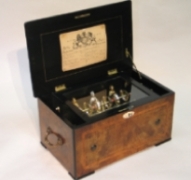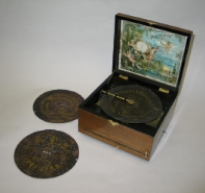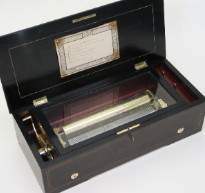
The origins of the familiar cylinder musical box exists in early clocks where the music was provided by a pinned cylinder activating a series of bells. At the end of the 18th century and early 19th century, technology allowed the bells to be replaced with a tuned steel comb. Consequently, the music could be much more elaborate.
People smile when they hear a musical box. Why do they find them so interesting? Maybe the mood or feeling of an earlier era is re-created. The sound of a properly restored musical box is exactly as it would have been when the machine was new, all those years ago. Each one of us has the opportunity to experience the delight and enchantment felt by William Gladstone or Queen Victoria. We can enjoy the entertainment that was so new in that other era.
Earlier types of cylinder musical boxes were often plain and understated. Despite the ‘cottage industry’ manufacturing, these machine often play with a soft tone that can be much sought after in musical box collecting circles.
The musical information, or code necessary for the production of the music is provided by a pinned cylinder. The cylinder of a musical box will slide on its longitudinal axis to enable more than one tune to be played. Each tune occupies one track or position on the cylinder.
Towards the later part of the 19th century, production methods became more sophisticated and mechanised. The manufacturers were exporting a large proportion of their output. Attendance at international trade exhibitions gave an idea of what the overseas buyer wanted. Competition drove manufacturers to supply boxes with ever more elaborate cases and tunes that were familiar to the potential customers. Brazilian rosewood veneered cases were popular in the UK and Europe while oak found favour in America.

Cylinder boxes are normally associated with Switzerland, in fact the production and export of musical boxes provided a significant contribution to the 19th century Swiss economy. Cylinder boxes were, however, produced in other countries including France, Germany and Austria.
The fixed program of, say, eight or twelve tunes would, perhaps, leave the owner wanting more variety. Interchangeable cylinder boxes were (and are) expensive. German engineers found an opportunity here, by developing the disc musical box. The cylinder was replaced by an easily interchangeable disc. The pins on the cylinder being replace by protrusions on the disc that rotate star shaped wheels which, in turn, pluck the tuned steel comb. The term ‘Polyphon’ has passed into the English language as the generic term for a disc musical box. Polyphon were just one manufacturer producing disc musical boxes at the turn of the 19th/20th century.

The musical box industry began to decline as new forms of home entertainment became available. The phonograph and the wireless turned musical boxes into the redundant technology that people stored in the outhouse of attic. Items once cherished were left to the ravages of damp and time.
The musical box industry all but died. Happily, what was once discarded technology has now embarked on a new era of popularity.
The restoration techniques that have been developed over the last forty years or so have enabled once treasured items of domestic entertainment to be resurrected, enabling us to gain an intriguing insight into the world of 19th century entertainment.
Copyright S.T.P. Kember 2025
